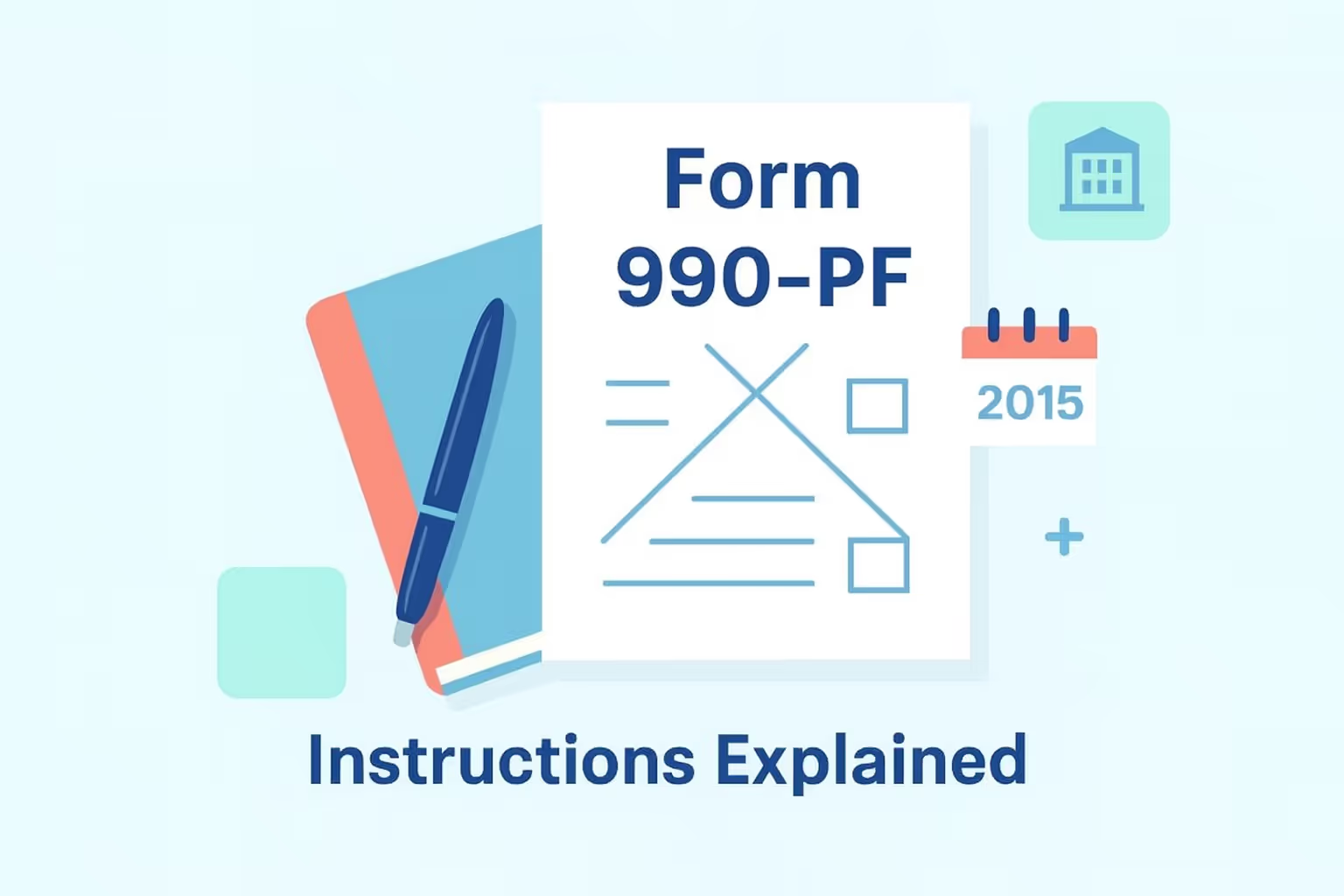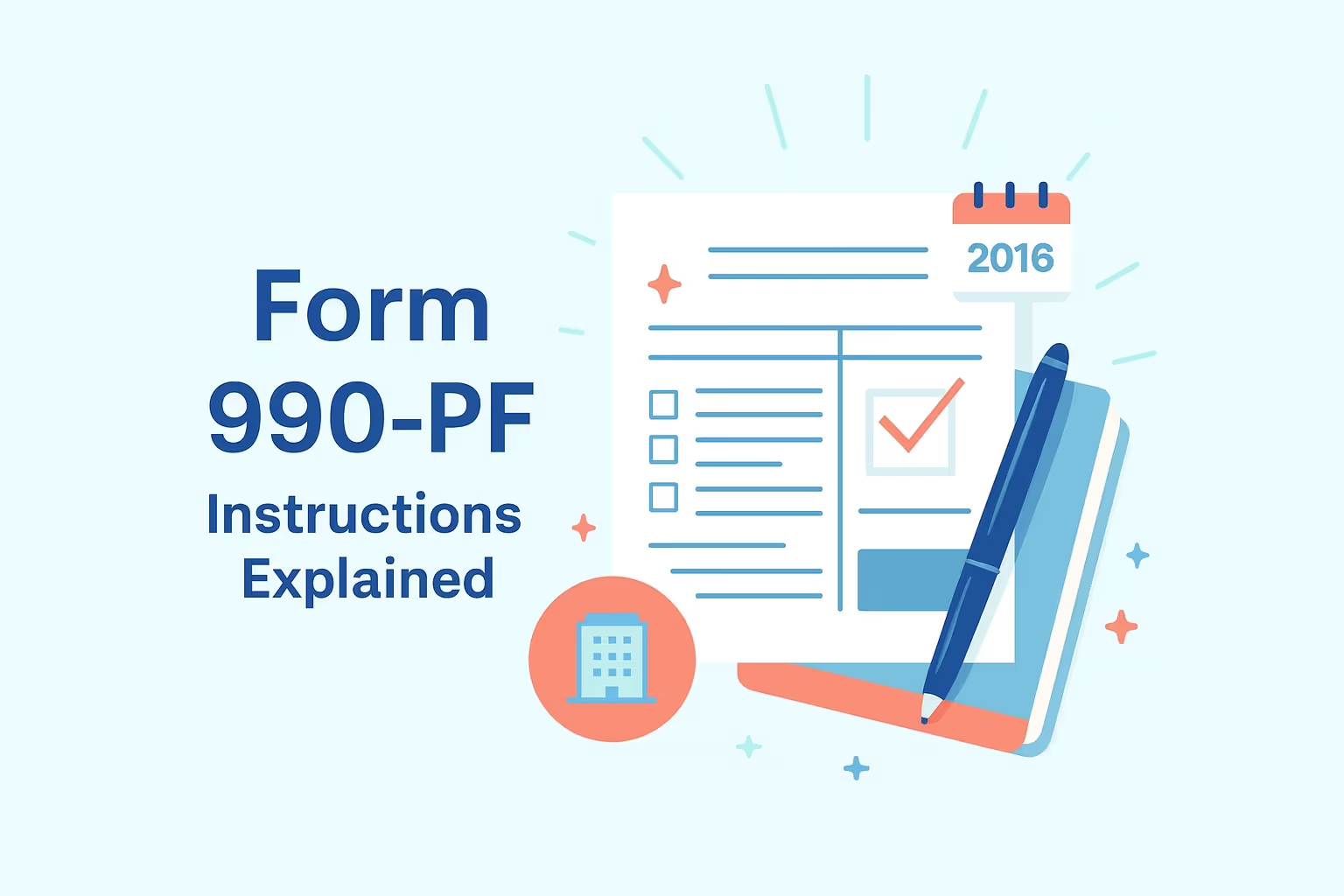Form 990-PF 2010 Instructions for Private Foundations
The Internal Revenue Service requires private foundations to file Form 990-PF each year. This annual information return documents a foundation’s charitable activities, financial support, and overall tax compliance. Each organization must accurately report gross receipts, contributions, capital gains, and program-related investments to maintain tax-exempt status under federal income tax law. Even without transactions during the calendar tax year, every foundation must file to remain in good standing with the IRS.
The purpose of Form 990-PF is to help the IRS evaluate how tax-exempt organizations manage funds and fulfill their charitable purposes. By providing a complete summary of the organization’s accounting period, net assets, and charitable distributions, the return ensures that nonprofit organizations operate within approved tax exemption guidelines. Precise and accurate reporting demonstrates a foundation’s commitment to transparency, which is essential to retaining tax-exempt status.
The Internal Revenue Service provides official requirements on the IRS Instructions for Form 990-PF (2010) page. The IRS resource provides step-by-step guidance to help charitable organizations complete Form 990-PF accurately, meet their federal reporting obligations, and safeguard their eligibility for continued exemption under federal law.
Understanding Private Foundations and Board Member Responsibilities
Private foundations play a vital role in supporting charitable activities and fulfilling exempt purposes under federal tax law. These organizations must accurately report to maintain their tax-exempt status and demonstrate the proper use of financial support. Every charitable organization must understand its structure, obligations, and leadership duties to remain compliant with the Internal Revenue Service.
What Defines a Private Foundation
- A private foundation is a charitable organization typically funded by a single contributor, such as a family or corporation. It often supports nonprofit programs or conducts direct charitable activities under strict federal oversight.
- Unlike public charities, foundations rely on limited funding sources and are required to report their charitable distributions annually through Form 990-PF.
- Each foundation must manage its assets, contributions, and grants in accordance with federal tax exemption requirements.
Filing Expectations and Oversight Duties
- Private foundations are required to file a complete annual information return, which details all revenue, expenses, and charitable distributions made during the year.
- Each return demonstrates how the organization’s gross receipts, net assets, and capital gains fund its mission and fulfill exempt purposes.
- Failure to meet filing obligations may negatively impact the foundation’s compliance record and lead to the loss of exempt status.
Governance and Accountability
- The board of directors oversees every aspect of a foundation’s financial support and operational integrity.
- Each member must ensure that all funds are directed toward qualified charitable activities consistent with the foundation’s primary purpose.
- Board members are responsible for approving grants, reviewing the annual return, and confirming that program-related investments align with organizational goals.
Reporting Roles and Disclosure Requirements
- Every officer, director, and trustee must be listed on Form 990-PF with accurate details, including their names, positions, compensation, and the number of hours worked.
- Foundations must disclose any related-party transactions or lobbying activities that could influence charitable operations.
- Signatures and certifications confirm that the return reflects a complete and truthful account of the organization’s financial activity.
Ensuring Transparency and Compliance
- Maintaining complete records of gross receipts, donations, and distributions demonstrates accountability to the Internal Revenue Service.
- Foundations must verify that all filings reflect the organization’s accounting period and document federal income taxes accurately, if applicable.
- Regular reviews of governance policies help safeguard the organization’s tax-exempt status and strengthen public trust.
A well-structured governance process ensures accurate filings, responsible management, and lasting compliance. Strong leadership fosters confidence among donors, beneficiaries, and regulators, enabling the foundation to sustain its charitable operations effectively.
Fiscal Year and Filing Requirements
Private foundations must adhere to a consistent filing schedule to maintain their tax-exempt status and demonstrate compliance with the Internal Revenue Service. The organization’s accounting period determines when its annual information return is due. Understanding each deadline, extension rule, and recordkeeping requirement helps secure the foundation’s position as a compliant charitable organization.
Step 1: Identify the Organization’s Accounting Period
Each foundation must determine whether it operates on a calendar tax year or a fiscal year. A calendar tax year runs from January 1 through December 31, while a fiscal year can end on the last day of any other month. Selecting the correct accounting structure ensures that gross receipts, contributions, and charitable activities are reported within the proper time frame for federal tax purposes.
Step 2: Determine the Filing Deadline
The Internal Revenue Service requires every private foundation to submit Form 990-PF by the fifteenth day of the fifth month after the close of its accounting year.
- A calendar-year foundation with a December 31 year-end must file by May 15.
- Filing on time reinforces accountability and helps preserve the federal tax exemption.
- Consistent adherence to deadlines confirms the organization’s reliability and commitment to accurate reporting.
Step 3: Request an Extension When Necessary
If additional time is needed, a foundation may file Form 8868 to obtain an automatic three-month extension. This period allows a thorough review of charitable distributions, capital gains, and other financial disclosures. The extension does not delay payment of federal income taxes on investment income; organizations must remit any owed amount by the original due date.
Step 4: Maintain Compliance Over Consecutive Years
Foundations must file an annual report, even when activity is limited. Missing filings for three consecutive years results in automatic revocation of tax-exempt status. Regular reporting of net assets and program-related investments reinforces transparency and demonstrates a dedication to continuous compliance.
Step 5: Report Zero-Activity Years
When a foundation has no revenue, grants, or charitable distributions, it must still file a complete annual return.
- Enter zeros in all financial sections to indicate inactivity.
- Submitting accurate zero-activity filings preserves exempt status and confirms operational continuity.
Step 6: Verify Records Before Submission
Before submitting the annual return, confirm that the reported data matches internal records. Review gross receipts, expenses, and charitable distributions carefully to ensure accuracy and completeness. Consistent, precise documentation supports future filings and strengthens the organization’s reputation for sound financial stewardship.
Staying organized and meeting all fiscal deadlines ensures long-term compliance, financial integrity, and protection of federal tax exemption. Each timely filing also reinforces the foundation’s commitment to responsible governance and transparent reporting.
Completing Form 990-PF: Section-by-Section Guide
Every private foundation must complete Form 990-PF accurately to demonstrate full compliance with the Internal Revenue Service. This annual information return records gross receipts, charitable distributions, and program-related investments. Understanding each section ensures that all disclosures match the organization’s accounting period and maintain its tax-exempt status.
Purpose and Scope of Form 990-PF
Form 990-PF applies to private foundations and specific nonprofit organizations under section 4947(a)(1). It reports financial support, operational activity, and compliance with federal tax exemption requirements. The IRS uses the form to assess whether the foundation’s income, expenditures, and grants align with its exempt purposes.
Each organization must disclose essential financial details and document operational data. Accurate reporting of net assets, gross receipts, and contributions demonstrates how resources advance charitable activities. Foundations must also document excise taxes, program-related investments, and charitable distributions to confirm compliance and maintain public trust.
Core Sections of the Form
- Heading: Enter the legal name, address, employer identification number, and accounting method. Identify the foundation type and reporting year. Accuracy in this section prevents classification errors and ensures IRS records reflect the correct entity information.
- Part I – Revenue and Expenses: Disclose contributions, investment income, and program-related costs. All entries must match internal records, and gross receipts should capture total inflows, including capital gains and grants. Clear, consistent reporting confirms the foundation’s ability to manage its financial support responsibly.
- Part II – Balance Sheet: Show beginning and ending balances for assets, liabilities, and net assets. Reconcile these figures with financial reports. If assets exceed $5,000, include fair market values to reflect an accurate snapshot of financial standing.
- Part III – Changes in Net Assets: Summarize how charitable distributions, gains, or losses affect overall financial standing. This section highlights responsible fund management and demonstrates that all financial activity supports exempt purposes.
- Part VI – Excise Tax on Investment Income: Calculate the tax on net investment income precisely. Report all taxable earnings to reinforce compliance and preserve exempt benefits.
- Part VII – Officers, Directors, and Trustees: List each individual’s name, position, hours worked, and compensation. Confirm that governance practices and compensation remain consistent with charitable intent.
Each part requires accuracy, transparency, and proper documentation. Foundations should reconcile all reported amounts with audited statements to ensure consistency across financial records. Maintaining detailed documentation of transactions, grants, and distributions reinforces compliance with IRS expectations and helps prevent discrepancies in filing.
Importance of Complete Reporting
Comprehensive reporting supports accountability, transparency, and legal compliance. Accurate completion safeguards the foundation’s exempt status and reinforces public confidence. Thorough attention to each section ensures continued trust in the organization’s charitable mission.
E-Filing and Submission Rules
Private foundations must understand how to submit their annual information return using the correct filing method. The Internal Revenue Service establishes clear standards for e-filing and paper submission to ensure that every organization reports accurate data and maintains its tax-exempt status. Selecting the appropriate method depends on the volume, size, and technical capabilities of the filing.
Filing Method Comparison
- Electronic Filing (E-Filing)
- Description: Required for organizations filing 250 or more returns annually, including all federal information returns
- Key Considerations:
- Faster processing and confirmation of receipt
- Fewer data-entry errors
- Ensures compliance with IRS e-filing requirements
- Paper Filing
- Description: Available to smaller organizations that do not meet the electronic filing threshold
- Key Considerations:
- Must be mailed to the correct IRS address (varies by location)
- Incomplete or misrouted filings can cause delays and affect compliance records
- E-Postcard (Form 990-N)
- Description: Designed for small tax-exempt organizations with gross receipts under $50,000
- Key Considerations:
- Simplifies filing and confirms the organization remains active
- Only applies to qualifying foundations with limited financial activity
- Amended Return
- Description: Used to revise an already submitted annual information return
- Key Considerations:
- Must check the “Amended Return” box and provide corrected figures
- Timely updates maintain accuracy and IRS record consistency
Electronic filing remains the most secure and efficient method for completing Form 990-PF. It reduces administrative errors and ensures all required data reaches the IRS promptly. The system also validates entries before submission, allowing organizations to correct missing information before finalizing the return.
Foundations that meet e-filing thresholds should follow official procedures outlined on the IRS e-file for Charities and Nonprofits page. This resource offers step-by-step guidance on authorized e-file providers, eligibility requirements, and approved software solutions. Using official channels supports accurate reporting and timely compliance with IRS filing standards.
All foundations, whether filing electronically or on paper, must verify the accuracy of their data before submission. Reviewing each section for accuracy ensures that contributions, gross receipts, and charitable distributions align with financial statements. Proper preparation demonstrates accountability and protects the organization’s tax-exempt status.
Choosing the correct filing method ensures timely submission and continued compliance with federal requirements. By following approved IRS processes, foundations maintain transparency, strengthen financial accuracy, and reinforce trust in their charitable operations.
Maintaining Exempt Status and Avoiding Compliance Issues
Private foundations must maintain full compliance with Internal Revenue Service requirements to preserve their tax-exempt status. Each organization must demonstrate accuracy, transparency, and accountability through every annual filing. Meeting these standards builds public trust and confirms the foundation’s commitment to lawful and ethical operations.
- Timely Filing: Foundations must submit Form 990-PF by the deadline determined through their accounting period. Filing on time demonstrates the organization’s commitment to accountability and compliance with federal reporting requirements, thereby safeguarding its exemption from federal income taxes and preventing disruptions to its charitable operations.
- Accurate Reporting: Each return must include verified data for gross receipts, contributions, and charitable distributions. Cross-check all figures against internal records before submission. Consistent filings establish year-over-year accuracy and demonstrate reliable financial oversight.
- Comprehensive Disclosures: Private foundations are required to disclose all charitable activities, program-related investments, and qualifying expenditures. Complete documentation shows that all funds are used exclusively for exempt purposes. Thorough disclosures reinforce transparency and confirm that operations align with the organization’s charitable mission.
- Recordkeeping Standards: Each foundation must maintain detailed records for a minimum of three years. Documentation should include gross receipts, donations, grants, and operational expenses. Organized recordkeeping supports accurate reporting and serves as documentation during compliance reviews.
- Avoiding Late or Incomplete Filings: Missing or incomplete filings can lead to the revocation of tax-exempt status. Failure to file for three consecutive years results in automatic loss of exemption. Maintaining consistent filings reinforces public confidence and demonstrates accountability to the IRS.
- Transparency and Public Disclosure: Form 990-PF is a publicly available document that allows stakeholders to review how funds are managed. Complete and honest disclosure strengthens credibility and highlights responsible governance. Transparency helps donors, beneficiaries, and regulators understand the organization’s financial stewardship.
- Governance Oversight: Board members and officers must regularly monitor compliance obligations and internal policies. Consistent oversight ensures that all operations remain aligned with exempt purposes. Effective governance prevents reporting errors and promotes ethical management.
Foundations may review annual expectations on the IRS Annual Filing and Compliance Requirements page. The resource outlines official filing standards, disclosure rules, and documentation requirements. Using this guide helps organizations track updates to compliance requirements.
Maintaining compliance affirms a foundation’s integrity and dedication to lawful operations. Diligent reporting, careful governance, and public transparency are essential for securing tax-exempt status and fostering lasting trust. Consistent adherence to IRS standards also strengthens the organization’s reputation for accountability.
Additional Requirements and Schedules
Private foundations must complete specific schedules and sections within Form 990-PF to meet IRS compliance standards. These additional requirements help the Internal Revenue Service confirm that financial activities align with the organization’s exempt purposes. Each part and schedule provides detailed insights into charitable distributions, asset reporting, and contributions.
Some schedules apply to all filers, while others depend on the foundation’s asset levels, grant activities, or income type. Every organization should review its structure, operations, and financial records before determining which parts must be completed. Accurate reporting across these sections demonstrates transparency and supports continued tax-exempt status.
- Schedule B (Schedule of Contributors): Required when a foundation receives $5,000 or more from one contributor during the year. Each entry must include donor information, type of contribution, and amount received. Reporting these details confirms proper documentation of significant financial support.
- Part II, Column (c): Mandatory for organizations holding at least $5,000 in assets at any time during the year. This section discloses fair market values to reflect accurate asset reporting. Maintaining precision in asset valuation supports financial accountability and reinforces public confidence.
- Parts X through XIII: Essential for calculating distributable amounts, qualifying distributions, and undistributed income. These sections confirm whether the foundation has met its minimum charitable payout requirements. Completing each part ensures that charitable distributions meet the federal threshold for compliance.
- Part XV (Supplementary Information): Used to report direct charitable activities and program-related investments. Each entry must describe how the activity or investment supports exempt purposes. This disclosure clarifies how funds contribute to the foundation’s mission and community benefit.
- Zero-Activity Reporting: Foundations with no contributions, grants, or distributions must still file a complete return. Enter “0” or “None” in applicable lines to record inactivity and preserve exempt standing. Dormant organizations remain subject to annual filing requirements regardless of operational level.
Every section and schedule plays a distinct role in reflecting financial transparency. Completing applicable parts with precision ensures the foundation fulfills its reporting duties. Consistent attention to these requirements demonstrates integrity, protects exemption benefits, and builds lasting credibility with regulators and the public.
Guidance for Small and First-Time Filers
First-time and small private foundations must approach Form 990-PF filing with careful preparation and a thorough understanding of IRS requirements. Accurate completion ensures compliance, supports transparency, and confirms eligibility for tax-exempt status. Following each step helps new filers establish reliable processes and avoid errors that could affect future filings.
- Identify the Foundation Type: Determine whether the organization qualifies as a private operating foundation, private nonoperating foundation, or section 4947(a)(1) trust. Classification affects reporting requirements, charitable distributions, and excise tax obligations. Understanding the foundation type ensures accurate completion of applicable sections throughout the annual information return.
- Gather Financial Records: Collect all documentation reflecting gross receipts, contributions, grants, and expenses. Organized records simplify the completion of financial sections and support accurate disclosures of charitable activities. Consistent recordkeeping also reinforces accountability and helps confirm the organization’s alignment with its exempt purposes.
- Review Exempt Purpose and Activities: Every filing should clearly show how the foundation’s work supports its charitable mission. New organizations must confirm that programs, grants, and investments advance exempt purposes recognized under federal law. Describing activities with precision reinforces the organization’s compliance and demonstrates adherence to tax-exempt guidelines.
- Understand the 5 Percent Distribution Requirement: Private foundations are required to distribute approximately 5 percent of their average net investment assets annually. Meeting this threshold ensures continued qualification for tax exemption and demonstrates active support of charitable causes. Tracking these distributions across reporting years verifies ongoing compliance with payout rules.
- Confirm the Correct Accounting Method: Select either the cash or accrual method and apply it consistently across all financial statements. The accounting approach influences how contributions, expenses, and investment income are reported. Uniform application supports accuracy in future filings and simplifies annual reconciliation.
- Address Zero-Activity Years Properly: Foundations with no revenue, contributions, or distributions must still file a complete Form 990-PF. Enter “0” or “None” where applicable to confirm inactivity. Submitting an accurate return, even during dormant periods, preserves tax-exempt status and demonstrates a commitment to compliance.
- Consider Professional Guidance: Consulting a tax professional or advisor experienced in nonprofit compliance can help small foundations meet filing standards. Expert review supports accurate reporting and helps resolve complex classification or disclosure issues. Early professional assistance builds confidence and reduces the risk of errors.
Completing these steps equips first-time filers with a strong foundation for ongoing compliance. Accurate reporting, consistent recordkeeping, and timely submissions build credibility with the IRS and reinforce commitment to lawful charitable operations.
Frequently Asked Questions
What is the fiscal tax year for private foundations?
The fiscal tax year represents the 12-month accounting period used to track a foundation’s financial activity and reporting obligations. A foundation may follow either a calendar year or select a different fiscal schedule that aligns with its operations. Choosing the appropriate fiscal tax year ensures accuracy in annual filings, helps maintain consistency across financial statements, and supports compliance with IRS requirements for the timely submission of Form 990-PF and related documents.
When should a foundation file Form 990-PF?
Private foundations must file Form 990-PF annually, based on the end of their fiscal tax year. The due date is the fifteenth day of the fifth month following the close of the reporting period. For example, organizations operating on a calendar year that ends on December 31 must submit their annual return by May 15 of the following year. Timely filing confirms compliance with federal regulations and protects the foundation’s tax-exempt standing with the IRS.
Who needs to file Form 990?
Organizations classified as tax-exempt under Section 501(c) generally must file Form 990 annually to maintain their tax-exempt status. Private foundations use Form 990-PF, while public charities and certain other entities file either the standard Form 990 or Form 990-EZ. Filing the correct IRS form helps document charitable activities, financial operations, and governance practices. Consistent submission ensures adherence to the Taxpayer Act and demonstrates ongoing accountability in meeting federal reporting obligations.
How does the e-filing process work for Form 990-PF?
The e-filing process allows private foundations to submit Form 990-PF electronically using authorized IRS software or approved providers. Electronic submission ensures faster processing, receipt confirmation, and error detection before finalization. The IRS requires electronic filing for organizations submitting 250 or more tax returns annually. Choosing e-filing helps streamline compliance, reduce manual errors, and support accurate reporting under federal tax-based requirements for nonprofit organizations.
Can small organizations use the e-Postcard option?
Smaller organizations meeting specific financial criteria may qualify to file Form 990-N, also known as the e-Postcard. This simplified return applies to entities with gross receipts typically at or below $50,000. Filing an e-Postcard confirms that the organization remains active and compliant with the IRS's annual reporting rules. Although it is easier to complete, foundations exceeding financial thresholds must still file the full Form 990-PF to meet federal requirements.
Are private foundations owned by a single family required to file annually?
Yes, a private foundation established and funded by a single family is required to file Form 990-PF each year, regardless of its activities. Filing ensures transparency, accountability, and continued recognition as a tax-exempt organization. Annual reporting also verifies that charitable distributions align with exempt purposes. Foundations with minimal or no activity must still report zero values to demonstrate operational continuity within their designated fiscal tax year.
What happens if a foundation changes its fiscal year or accounting period?
When a foundation changes its accounting schedule, it must notify the IRS and adjust future reporting to reflect the new fiscal tax year. A short-year return may be required for the transitional period. The organization must continue to file Form 990-PF annually to maintain compliance with its federal reporting obligations. Aligning financial reporting with the revised accounting period ensures consistency, accuracy, and adherence to IRS annual filing standards.




























